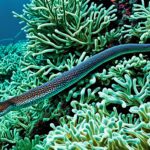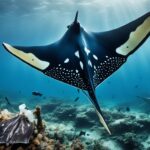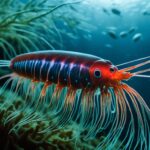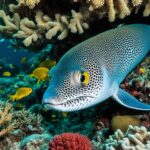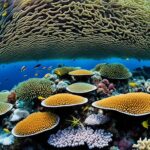Sea urchins play a big role in marine ecosystems. They are key to how different marine species interact with each other. By eating algae, they help control plant growth in the ocean. They also have relationships with predators and other sea creatures that are important for the balance of the ocean.
These interactions show us how complex ocean life is. They also show us the problems our oceans face today.
Understanding Sea Urchin Behavior
Sea urchins live fascinating lives under the sea. Their bodies show how they adapt to their underwater world. They have spiny shells and special feeding tools that help them survive in the ocean.
Physical Characteristics of Sea Urchins
Sea urchins are known for their round bodies covered in spines. These spines keep them safe from predators and help them hide on the ocean floor. They have a hard outer shell called a test that can change color and texture. This helps them blend in with their surroundings, making it harder for predators to find them.
Movement and Feeding Techniques
Sea urchins have interesting ways of moving and eating. They use their tube feet to move slowly or quickly through the water. Their special tool, called Aristotle’s lantern, lets them eat algae and other food from surfaces.
This helps them play a key role in the ocean’s balance. They eat both plants and animals, keeping the ecosystem healthy.
| Characteristic | Description |
|---|---|
| Body Shape | Globe-shaped with a hard exoskeleton |
| Spines | Used for protection and camouflage |
| Movement | Utilizes tube feet for locomotion |
| Feeding Structure | Aristotle’s lantern for scraping food |
| Diet | Primarily omnivorous, feeding on algae and other marine life |
Sea Urchin Predators and their Role
Sea urchins and their predators have a big impact on the health of marine ecosystems. Many marine animals help control sea urchin numbers. This balance is key to the food web’s health.
Common Predators of Sea Urchins
Several animals are threats to sea urchins, keeping their numbers in check. Key predators include:
- Sea Otters – These animals eat a lot of sea urchins.
- Starfish – Some starfish use their feet to open sea urchin shells.
- Various Fish Species – Fish like triggerfish and wrasses hunt sea urchins.
Impact of Predation on Sea Urchin Populations
Predators have a big effect on sea urchins. They help keep their numbers from getting too high. If sea urchins eat too much algae, it can harm coral reefs and marine life.
This balance between predators and sea urchins affects the whole marine food web.
| Predator Type | Feeding Method | Impact on Sea Urchin Population |
|---|---|---|
| Sea Otters | Directly consume sea urchins | Significant control of sea urchin numbers |
| Starfish | Pries open shells | Reduces sea urchin density |
| Fish Species | Hunt and consume sea urchins | Contributes to population regulation |
How do sea urchins interact with other marine life?
Sea urchins are key players in marine ecosystems. They interact with many marine species in complex ways. These interactions show how sea urchins help maintain the balance in the ocean.
Symbiotic Relationships with Marine Species
Sea urchins have interesting symbiotic relationships with other sea creatures. For example, carrier crabs use sea urchins for protection. The urchins’ sharp spines keep predators away, helping both species.
Some fish also live among sea urchins for safety. They clean the urchins by removing parasites. These partnerships show how sea urchins are important in the ocean.
Importance in Marine Ecosystems
Sea urchins are crucial for ocean health. They eat algae, which stops it from taking over coral reefs. This balance is key for a healthy ocean.
Without sea urchins, coral reefs might not survive. They help keep the ocean stable and full of life. Sea urchins are true unsung heroes of the sea.
| Symbiotic Relationship | Benefit to Sea Urchin | Benefit to Marine Partner |
|---|---|---|
| Carrier Crab | Protection from predators | Refuge and camouflage |
| Cleaner Fish | Reduced parasite load | Source of food |
| Sea Anemones | Extra protection | Access to food scraps |
Sea Urchin Ecological Role
The sea urchin plays a key role in its underwater world. It helps keep the balance of algae, which affects coral reefs’ health.
Grazing Behavior on Algae
Sea urchins eat a lot of algae. This stops algae from growing too much and covering corals. They keep algae in check, which is good for the ocean’s balance.
Without sea urchins, algae could take over. This would harm corals and many other sea creatures.
Influence on Coral Reefs
Sea urchins help coral reefs stay healthy. They eat algae, which helps corals thrive. This makes reefs more diverse.
Healthy sea urchin numbers are important for reefs. They keep algae from growing too much. This helps corals and protects the coast from harm.
Marine Biodiversity Interactions
Understanding life in marine ecosystems is key. Sea urchins are crucial in these systems. They help increase diversity and keep the environment balanced for many species.
Diverse Interactions within Marine Ecosystems
Sea urchins have many interactions with other sea creatures. They compete with fish and mollusks for food. At the same time, they help manage algae and coral communities.
This shows how sea urchins affect species populations and where they live. They are key to keeping the ecosystem in balance.
Contribution to Species Diversity
Sea urchins are important for marine ecosystem diversity. They provide homes and food for many animals. For example, fish use urchin beds to breed.
Sea urchins eat algae and affect the balance of their habitats. This helps keep the ocean healthy and full of different species.
Sea Urchin Symbiosis with Crabs
The bond between sea urchins and crabs is a great example of how marine life works together. Crabs get extra protection from sea urchins. At the same time, they help sea urchins in big ways. This shows how important their partnership is in the ocean.
Mutual Benefits for Crabs and Urchins
Crabs and sea urchins have a special deal in the sea. Crabs, like carrier crabs, use sea urchins as shields. They stick to the urchin’s spines, making it hard for predators to spot them. This helps crabs live longer.
Sea urchins get to move around better because of this partnership. They can eat more algae and other food. This teamwork shows how different species can help each other to survive.
Caddy Crabs: A Case Study
Caddy crabs are a great example of this partnership. They attach to sea urchins to stay safe from predators. This helps the crabs and the urchins to eat better. Watching these crabs and urchins helps us understand their world and how they affect the ocean.
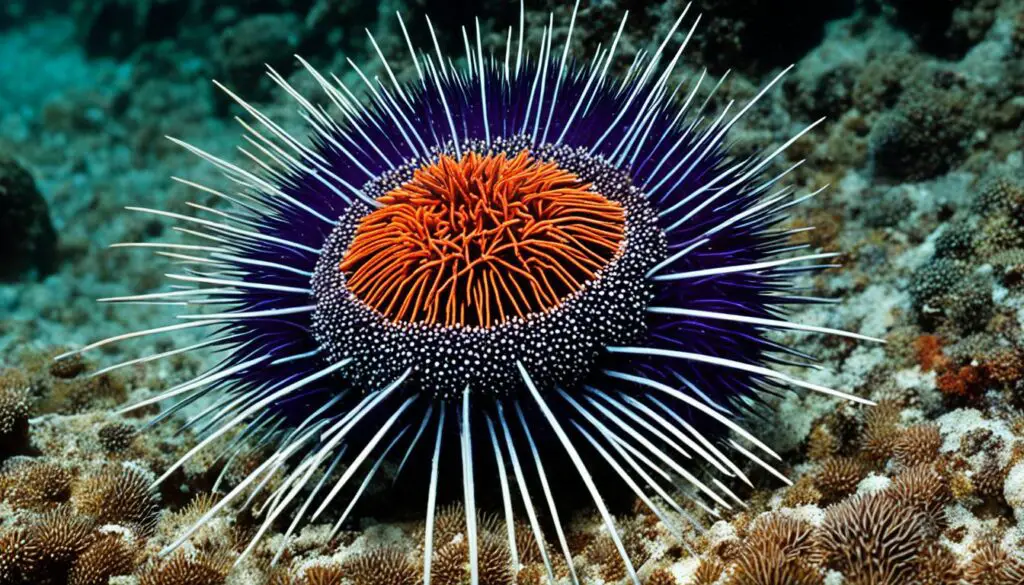
| Aspect | Sea Urchins | Crabs |
|---|---|---|
| Primary Benefit | Mobility and Grazing | Camouflage and Protection |
| Attachment Method | N/A | Using Urchin Spines |
| Survival Strategy | Enhanced Feeding | Avoidance of Predators |
| Impact on Ecosystem | Algal Control | Population Balance |
Impact of Environmental Changes on Sea Urchin Interactions
Understanding how environmental changes affect sea urchin interactions is key to knowing how marine ecosystems work. Climate change is making big waves for sea urchins. Changes in temperature and weather patterns are messing with their homes. This leads to challenges that change their behavior and how they interact with others in the ocean.
Effects of Climate Change on Sea Urchins
Climate change is bringing the heat, and it’s not good for sea urchins. Higher temperatures can slow down their growth, make it harder for them to reproduce, and make them easier prey. As they try to adapt, their eating habits and how they interact with other sea creatures might change too. This could shake up the balance in marine ecosystems.
Salinity Levels and Movement Challenges
Salinity, or the amount of salt in the water, is a big deal for sea urchins. When it changes because of things like more rain or fresh water, sea urchins can struggle. Low salinity makes it tough for them to stick to surfaces, which makes moving around hard. This can cut down on how well they can find food, which affects their role in the ocean and the health of the ecosystem.
| Environmental Factor | Impact on Sea Urchins | Potential Consequences |
|---|---|---|
| Temperature Increase | Affects growth and reproduction | Altered population dynamics |
| Fluctuating Salinity | Challenges in movement and adhesion | Reduced foraging efficiency |
| Altered Ecosystem Relationships | Changes in grazing behaviors | Perturbation of marine biodiversity |
Future of Sea Urchin Interactions in Marine Ecosystems
Looking ahead, sea urchins will play a key role in marine ecosystems. They are crucial for keeping their habitats in balance. But, changes in the environment could change how they interact with their surroundings.
As climate change advances, sea urchins might change how they eat, reproduce, and interact with predators and prey. These changes will affect many species that depend on them. So, it’s important to protect sea urchin habitats to keep coral reefs and other marine areas healthy.
Research on sea urchins is vital for the future. By helping them thrive, we can keep them supporting marine ecosystems. Focusing on sea urchins in conservation efforts will help maintain a diverse and strong marine world for the future.


